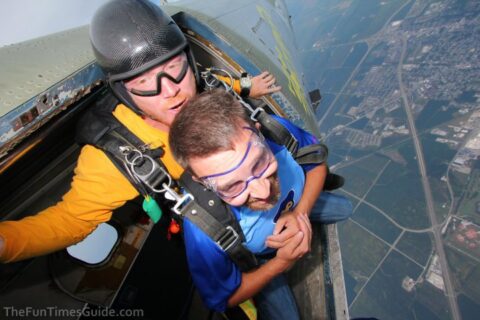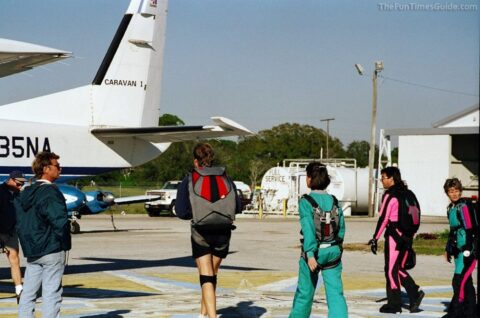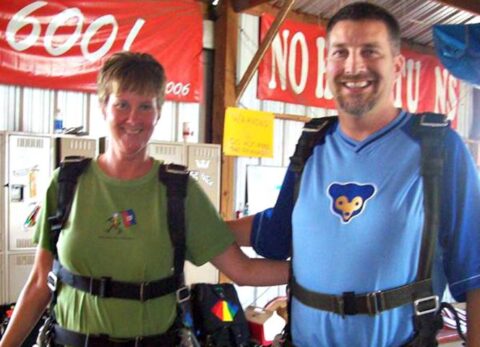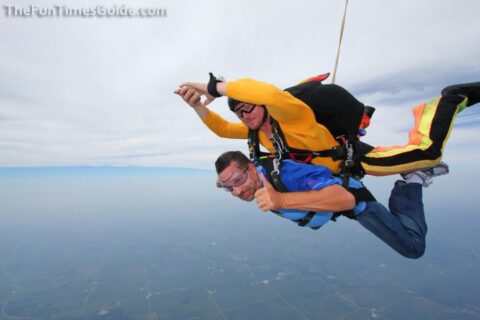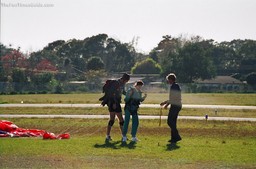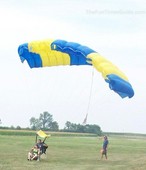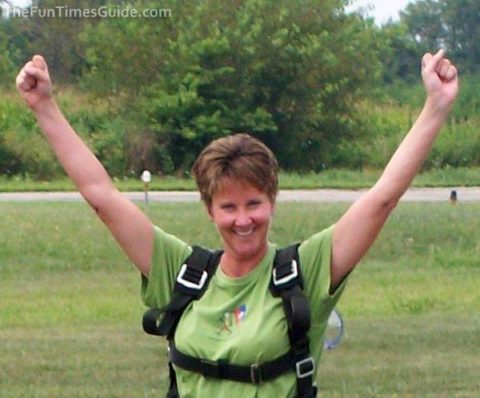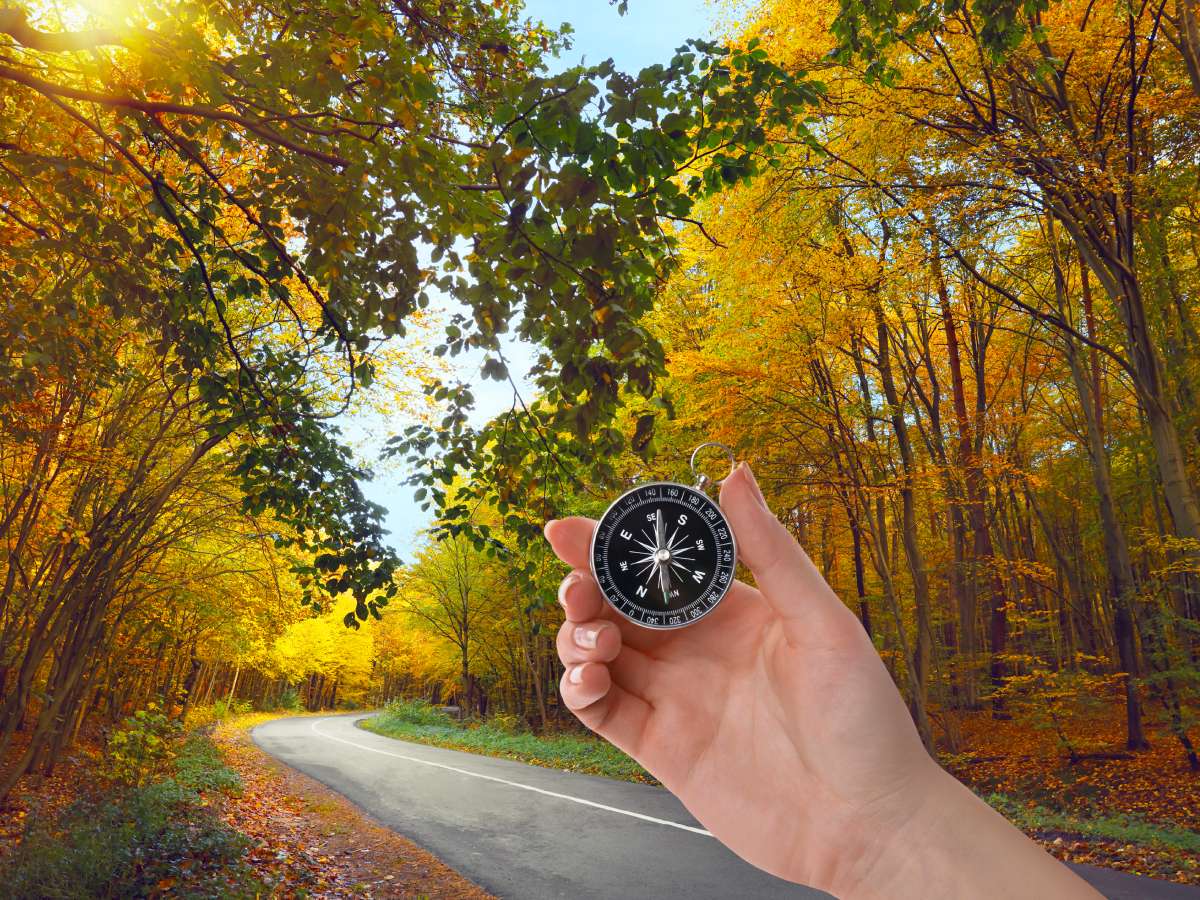“I’ve always wanted to go skydiving.”
I heard someone say this across a crowded dinner table, and I said, “Oh, me too!” Another person said “Well, you should do it.”
Skydiving is a challenge that I accepted first in 1994 and 5 times since then.
I didn’t expect to do it more than once, but the thrill is just too hard to resist.
I have no desire to become a solo skydiver, but I love tandem skydiving — where the professional skydiver does all the work and I just hang along for the ride!
For my first jump, I really had no idea what to expect. This was in the pre-YouTube days, so I had only seen skydiving on TV (and nothing specifically about tandem jumping).
I knew I would be connected to a professional skydiver, and I now describe tandem skydiving as “you’re wearing the instructor like a backpack!”
Here are a few things that will help prepare you for your first time skydiving…
First Time Skydiving Tips
I recommend choosing a drop zone that supports the United States Parachute Association rules and regulations.
Use this Drop Zone Locator to find skydiving locations near you.
Here are some skydiving tips that are pretty common at drop zones across the US:
- At most places you must be at least 18 years old (take a valid photo ID), with a weight limit of around 250 lbs. — based on the weight limits of the skydiving equipment. (Usually, the total weight of the tandem pair cannot exceed 500 lbs.)
- Loose-fitting clothes are definitely a good idea — as are comfortable, sturdy, fully-attached shoes. (No flip flops!)
- Call ahead for a reservation, if you can. However, larger drop zones try to accommodate walk-ins.
- Prepare to spend several hours at the drop zone — sometimes up to half a day, depending on the weather and the staffing situation at that site. Feel free to take snacks and bottled drinks (no alcohol) — in case vending machines aren’t available.
- Leave all valuables locked inside your car or with a friend on the ground. There may be lockers for your things, but probably not. There’s typically a place to leave your car keys.
- If you wear glasses or contacts, talk to the staff at the jump site to make sure their goggles will protect your eyewear.
- A couple of jumps ago, I discovered I am becoming more sensitive to motion sickness. For my recent jump, I took a non-drowsy Dramamine and that did the trick.
- You will watch a video about tandem skydiving that describes the process. I’ve seen several versions of this video. Some of them will be similar to the video you might choose to buy of your own jump.
Tandem Skydiving Liability & Risks
While watching the video (or perhaps after), you’ll review and sign several pages of waivers — including liability and photograph/video releases.
The skydiving liability waivers are pretty serious, holding harmless the obvious suspects (your tandem instructor, plane pilot, owner of drop zone, etc.) as well as some unexpected others (people who made and designed the airplane parts and the farmer who owns the field next to the landing site, in case you land in his field — seriously!).
Read it as thoroughly as you would any legal document that says you’re about to participate in a death-defying jump from an airplane.
Of course there are risks. You might want to review the tandem skydiving statistics — if that’s what you’re into. Be warned that many statistic sites start off with scary things like skydiving fatalities per year.
I know it’s risky, but I’ve never been overly concerned about it. I guess I buy into the theory that I’m more likely to be injured while driving my car to the drop zone than during the actual skydive.
Skydiving deaths are rare. In 2019, there were 15 fatal skydiving accidents in the United States out of about 3.3 million jumps — according to the United States Parachute Association. Tandem skydiving is even safer, with one student death per 500,000 tandem jumps in the past decade. Source
Once the paperwork is complete, it will be time to pay the piper. Plan to pay around $200 for a tandem skydive — and up to $100 more for extras like video and pictures. Most places will accept payment by cash, check, or credit card. Be sure to ask (or check their website) in advance, so you don’t show up unable to pay.
You might be wondering… what if I change my mind?
- You’ll need to ask the drop zone’s policy on this.
- One place I went to allowed you to change your mind until you stepped in the plane.
- Another place gave no refunds after you made the payment.
- Keep in mind that they can’t make you jump out of the plane. You can get all the way to the open door of the plane and decide you don’t want to do it. (In that case, enjoy the rest of your expensive plane ride back to the airport!)
The bottom line: skydiving is an adventure. It’s not for everyone — but when you know ahead of time what it’s like and how to prepare, you’ll be more likely to enjoy your first time skydiving.
Ready to move on? These next few skydiving tips will give you a better idea of what the gear and equipment is like and what you can expect during the actual jump…
Your Skydiving Gear & Jump Master
Once all the paperwork is done, you’ll meet your “jump master” — your very own professional tandem skydiving instructor. (All of mine have been guys, so I will refer to the jump master as “he”.)
He’ll start to explain the process and your gear.
Did You Know?… A tandem jump-master has made at least 500 jumps (in many cases, several thousand!) and has gone through a rigorous training program.
The gear you use will depend on your drop zone, but one thing is universal and that’s your harness.
I’ll tell you right now… it is uncomfortable. It’s similar to a rock climbing or rappelling harness and is specifically designed to connect you to your skydiving instructor. Just plan on having a wedgie and a tough time breathing. But remember, you want the harness to be tight and secure!
The skydiving harness connects you to your instructor with clips in 4 places:
- 2 at shoulders
- 2 at hips
You won’t “hook up” until right before you jump out of the plane.
You’ll also be given a pair of goggles to wear. Other gear may include a jumpsuit and a helmet.
The helmet is soft-cloth and more to keep long hair from flying in your face than for real protection. As Jerry Seinfeld said: “If you jump out of that plane and that chute doesn’t open, the helmet is now wearing you for protection!”
In tandem skydiving, the instructor wears the parachute pack on his back.
Here’s more about the equipment used for a tandem skydive:
- The large parachute is specifically designed for tandem skydiving and can safely hold 2 people.
- There is also a drogue chute that is deployed immediately after exiting the plane.
- The drogue will help slow down the descent of 2 jumpers to the more normal speed of 120 mph — which is necessary for the parachute to open safely.
- The parachute is usually deployed at 5,500 feet.
- There is a secondary reserve chute and an automatic activation device (AAD) that will automatically open the parachute around 2,000 feet — if it has not already been opened.
Once you’re suited up, it’s time to go!
Does Plane Size Matter?
I’ve jumped out of planes about the size of a VW bug and as large as a single-car garage.
The only difference in my opinion is:
- With a smaller plane, there will be some added preparation at the plane — with instruction on how to exit the plane in the air.
- With a larger plane, you’ll walk right in and probably walk right out — at 10,000 feet.
Regardless of plane size, the ride up in the plane will take about 15 minutes. Enjoy the ride!
You’ll be sitting in front of your skydiving instructor — probably packed in like a sardine along with other skydivers.
TIP: Try to catch a glimpse of the instructor’s altimeter on the way up — it’s kinda cool to watch it go from zero to 10,000 feet! (Or higher — my highest jump was from 13,500 feet.)
Ready, Set… Jump!
On the way up, you’ll receive even more skydiving tips.
The instructor will tell you how things will go and what you need to do on your skydive. It will go something like this:
- At around 8,000 feet, the instructor will attach himself to your harness.
- At 10,000 feet you and he will waddle your way close to the door. (It isn’t easy to move with a person on your back!)
- At the door, you will cross your arms over your chest, lift your feet and hang (!) from your instructor, and lay your head back on his shoulder.
- While you’re hanging from your instructor, he may lean out of the open doorway several times to view the ground.
- When you’re over the drop zone, the skydiving instructor will step (or flip!) out of the plane and YOU ARE NOW IN FREEFALL! Remember, you’re falling at 120 mph.
TIP: Try to catch a glimpse of the plane as you fall away from it. It will be the only thing up there to give you the perspective of falling. It actually feels like flying.
- You’ll freefall for 45 to 60 seconds. Try to pay attention to every second of it — it goes quickly!
TIP: During freefall, the instructor may do some turns left and right — to make it more exciting for you. You probably won’t be able to hear the instructor very well, but he may try to tell you things by speaking directly into your ear. Because of your instructor’s body positioning, your body will be in a backbend (or U-shape) position — keep your knees bent and your feet up between the legs of your instructor. You’ll receive a tap on your shoulder from the instructor — signaling that you can open your arms into a “touch down” position.
- Around 5,500 feet, the skydiving instructor will deploy the parachute. Expect a sudden jerk that will actually stop your fall and lift you up for a couple of seconds. You’ll be reminded how tight your harness is!
TIP: I’ve heard this described as the “trap door” effect. It’s at this moment your brain will think “Hey, I’m falling!”
- When the parachute is up (or “under canopy”), your instructor will loosen the 2 links at your hips — this will make you much more comfortable. He will be working on all the gear with the parachute. You’ll be able to easily talk to each other. At one point he will say, “Hold out your hands and grab these.”
TIP: Hold on tightly — those will be the parachute toggles! Yep, you’ll be driving the train, because he needs both hands free for a very short time while adjusting the gear. Don’t worry, he’ll take them back.
- The ride under canopy will be anywhere from 4 to 8 minutes — depending on the weather, your instructor’s personality, and your desire to play around.
TIP: For me, spinning around up there is the highlight of the ride — almost better than freefall. There’s absolutely nothing you can hit!
- You’ll soon realize that things on the ground are getting closer — which means it’s time to think about landing. Your job will be to pull your knees up to your chest. Your instructor will tell you when. Right before the landing, it will feel like the ground is rushing up at you — because it is! Keep your knees up until the skydiving instructor’s feet land on the ground and he says, “Now, just stand up. Perfect landing! Time to celebrate!”
Your instructor will say to you “legs up.” That means, lift your legs. It’s important for your legs not to touch down first. Visualize an airplane coming in for a landing. To land smoothly, the plane needs to land on the rear wheels first (the instructor’s legs) and the nose wheel second (your legs). Source
Congratulations… you’re now a skydiver!
What’s The Next Step?
A tandem skydiving jump can be:
- A one-time thing – as I thought my very first skydive would be.
- A fun hobby to pursue on occasion – as my skydiving adventures have become.
- The first step towards becoming a certified solo skydiver – not sure I’m ready for that yet!
Most drop zones offer accelerated freefall training, if you’re interested.
If you feel the need to jump out of a perfectly good airplane every now and then — don’t say I didn’t warn you!
More Tandem Skydiving Tips
In addition to the links I’ve included above, here are some other resources to help you prepare for your first skydive:

